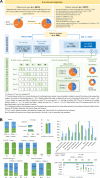Improving the prediction of Spreading Through Air Spaces (STAS) in primary lung cancer with a dynamic dual-delta hybrid machine learning model: a multicenter cohort study
- PMID: 37996894
- PMCID: PMC10668492
- DOI: 10.1186/s40364-023-00539-9
Improving the prediction of Spreading Through Air Spaces (STAS) in primary lung cancer with a dynamic dual-delta hybrid machine learning model: a multicenter cohort study
Abstract
Background: Reliable pre-surgical prediction of spreading through air spaces (STAS) in primary lung cancer is essential for precision treatment and surgical decision-making. We aimed to develop and validate a dual-delta deep-learning and radiomics model based on pretreatment computed tomography (CT) image series to predict the STAS in patients with lung cancer.
Method: Six hundred seventy-four patients with pre-surgery CT follow-up scans (with a minimum interval of two weeks) and primary lung cancer diagnosed by surgery were retrospectively recruited from three Chinese hospitals. The training cohort and internal validation cohort, comprising 509 and 76 patients respectively, were selected from Shanghai Chest Hospital; the external validation cohorts comprised 36 and 53 patients from two other centers, respectively. Four imaging signatures (classic radiomics features and deep learning [DL] features, delta-radiomics and delta-DL features) reflecting the STAS status were constructed from the pretreatment CT images by comprehensive methods including handcrafting, 3D views extraction, image registration and subtraction. A stepwise optimized three-step procedure, including feature extraction (by DL and time-base radiomics slope), feature selection (by reproducibility check and 45 selection algorithms), and classification (32 classifiers considered), was applied for signature building and methodology optimization. The interpretability of the proposed model was further assessed with Grad-CAM for DL-features and feature ranking for radiomics features.
Results: The dual-delta model showed satisfactory discrimination between STAS and non-STAS and yielded the areas under the receiver operating curve (AUCs) of 0.94 (95% CI, 0.92-0.96), 0.84 (95% CI, 0.82-0.86), and 0.84 (95% CI, 0.83-0.85) in the internal and two external validation cohorts, respectively, with interpretable core feature sets and feature maps.
Conclusion: The coupling of delta-DL model with delta-radiomics features enriches information such as anisotropy of tumor growth and heterogeneous changes within the tumor during the radiological follow-up, which could provide valuable information for STAS prediction in primary lung cancer.
Keywords: Deep learning; Lung cancer; Radiomics; Spreading through air spaces (STAS).
© 2023. The Author(s).
Conflict of interest statement
The authors declare no competing interests.
Figures







Similar articles
-
A CT-based deep learning radiomics nomogram for predicting the response to neoadjuvant chemotherapy in patients with locally advanced gastric cancer: A multicenter cohort study.EClinicalMedicine. 2022 Mar 21;46:101348. doi: 10.1016/j.eclinm.2022.101348. eCollection 2022 Apr. EClinicalMedicine. 2022. PMID: 35340629 Free PMC article.
-
Performance of deep learning model and radiomics model for preoperative prediction of spread through air spaces in the surgically resected lung adenocarcinoma: a two-center comparative study.Transl Lung Cancer Res. 2024 Dec 31;13(12):3486-3499. doi: 10.21037/tlcr-24-646. Epub 2024 Dec 27. Transl Lung Cancer Res. 2024. PMID: 39830743 Free PMC article.
-
Role of radiomics in predicting lung cancer spread through air spaces in a heterogeneous dataset.Transl Lung Cancer Res. 2022 Apr;11(4):560-571. doi: 10.21037/tlcr-21-895. Transl Lung Cancer Res. 2022. PMID: 35529792 Free PMC article.
-
Advances in the prediction of spread through air spaces with imaging in lung cancer: a narrative review.Transl Cancer Res. 2023 Mar 31;12(3):624-630. doi: 10.21037/tcr-22-2593. Epub 2023 Mar 1. Transl Cancer Res. 2023. PMID: 37033348 Free PMC article. Review.
-
A narrative review of preoperative CT for predicting spread through air spaces of lung cancer.Transl Lung Cancer Res. 2025 Apr 30;14(4):1471-1481. doi: 10.21037/tlcr-24-952. Epub 2025 Apr 27. Transl Lung Cancer Res. 2025. PMID: 40386727 Free PMC article. Review.
Cited by
-
Lobar versus sub-lobar resection for clinical stage IA (≤ 2 cm) lung neuroendocrine tumor with spread through air spaces: a multi-center study.Updates Surg. 2025 Jun 21. doi: 10.1007/s13304-025-02289-9. Online ahead of print. Updates Surg. 2025. PMID: 40544229
-
Deep Learning Analysis for Predicting Tumor Spread through Air Space in Early-Stage Lung Adenocarcinoma Pathology Images.Cancers (Basel). 2024 Jun 3;16(11):2132. doi: 10.3390/cancers16112132. Cancers (Basel). 2024. PMID: 38893251 Free PMC article.
-
Diagnostic performance of radiomics analysis for pulmonary cancer airway spread: a systematic review and meta-analysis.Diagn Interv Radiol. 2025 Apr 28;31(3):215-225. doi: 10.4274/dir.2024.242852. Epub 2025 Apr 7. Diagn Interv Radiol. 2025. PMID: 40192338 Free PMC article.
-
Development and validation of a predictive model combining radiomics and deep learning features for spread through air spaces in stage T1 non-small cell lung cancer: a multicenter study.Front Oncol. 2025 May 8;15:1572720. doi: 10.3389/fonc.2025.1572720. eCollection 2025. Front Oncol. 2025. PMID: 40406248 Free PMC article.
-
Lung Cancer Surgery in Octogenarians: Implications and Advantages of Artificial Intelligence in the Preoperative Assessment.Healthcare (Basel). 2024 Apr 7;12(7):803. doi: 10.3390/healthcare12070803. Healthcare (Basel). 2024. PMID: 38610225 Free PMC article. Review.
References
Grants and funding
LinkOut - more resources
Full Text Sources

